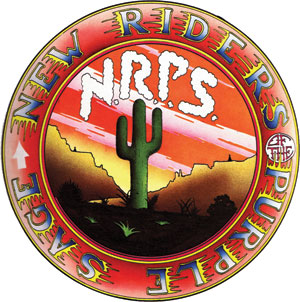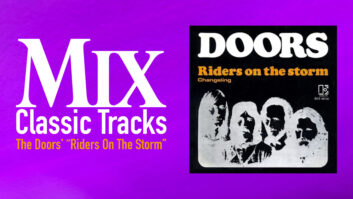
After psychedelic music had its heyday in the late 1960s, many musicians decided to take a trip sideways down country roads. The Flying Burrito Brothers and Poco both put out their excellent first albums in 1969, and that was also the year that Dylan cut Nashville Skyline and The Band released their roots-y “Brown Album.”
Meanwhile, the Grateful Dead hit the apex of their psychedelic evolution in the winter of 1969 (when Live Dead was recorded), yet shortly after that, Jerry Garcia’s songwriting and playing took a decidedly country turn. He and lyricist Robert Hunter simplified their style and started turning out the country-tinged material that would grace their 1970 commercial breakthrough, Workingman’s Dead. It was during the Dead’s spring ’69 tour that Garcia bought a Zane-Beck pedal steel guitar, and as soon as he got back to the Bay Area, he hooked up with a young, country music-loving singer-songwriter named John “Marmaduke” Dawson (who had been on the periphery of the Dead scene since their earliest days), and started playing low-key gigs as a duo in small venues south of San Francisco, highlighting Dawson’s originals and a selection of Bakersfield and Nashville numbers.
“At first, Garcia didn’t have the slightest idea what the real steel players were up to,” Dawson told me in the late ’90s. “What he played was just his idea of what they were doing and what sounded good to him… He didn’t read any books; he just sat down and played.” And like everything Garcia played, his work on the pedal steel came out sounding uniquely like him. “After a while,” Dawson added, “we decided to make a little band out of it.”
The group was dubbed The New Riders of the Purple Sage (after a Zane Grey cowboy novel), and in its first real incarnation, it was three-fifths Grateful Dead members: Garcia on pedal steel, Phil Lesh on bass and Mickey Hart—in whose Marin County barn studio they rehearsed—on drums, joined by leader Dawson and David Nelson (who went back to Garcia’s pre-Dead folk days). By August 1969, the New Riders went on the road as opening act for the Dead on a tour, and the response from Dead fans was rapturous. So it was no surprise when record companies started sniffing around and the group decided to make an album. In November 1969, they made a four-song demo, but it would be another year before they set out to formally make their first album, at Wally Heider Studio in San Francisco, and sign with CBS.
During that intervening year, the New Riders continued to open for the Dead fairly often, Lesh was replaced by bassist David Torbert, and shortly after the sessions for the album began, Mickey Hart was replaced by former Jefferson Airplane drummer Spencer Dryden. By the time those sessions rolled around, too, Garcia had become the in-demand pedal steel player in the Bay Area, having worked on records by Jefferson Airplane; Paul Kantner; Brewer & Shipley; Crosby Stills, Nash & Young; David Crosby; and the Dead’s two 1970 discs, Workingman’s Dead and American Beauty. That last Dead album had been engineered and co-produced at Heider’s by Stephen Barncard, who also cut Garcia’s pedal steel part for CSNY’s “Teach Your Children” there.
Barncard, who was an experienced engineer in his native Kansas City, arrived in the Bay Area in mid-1969, just as Heider’s facility was getting off the ground. Hired as an assistant by Heider himself, Barncard’s early work at the studio included sessions for Harry Nilsson, Jefferson Airplane, CSNY and others, but American Beauty was his big early break as lead engineer, followed by David Crosby’s landmark first solo album. That led to his being asked to engineer and co-produce (with Phil Lesh) the Riders’ debut album. By that point, the group had honed Dawson’s original songs through playing them on the road, so the sessions at Heider’s upstairs Studio C were cut mostly live (with vocals and a few overdubs added).
Dawson’s country-rock tunes covered a broad spectrum of topics, from love songs (“All I Ever Wanted,” “I Don’t Know You,” “Louisiana Lady”) to ecological anthems (“Last Lonely Eagle,” “Garden of Eden”), a spry train robbery tune (“Glendale Train”) and this month’s Classic Track, “Dirty Business,” a brooding epic about a mining disaster and the poor folks caught up in the tragedy. It was a centerpiece of the group’s sets during the era when Garcia was the Riders’ steel guitarist (he was replaced by Buddy Cage in the fall of ’71), famous for his snarling and crackling fuzzed steel line.
“He had a [Dunlop] Fuzz Face, a real cheap diode square-waver—that’s what sufficed for fuzz in those days,” Barncard says. “The pedal industry hadn’t matured, so they were hand-built and noisy, but they did what was advertised, which was distort the signal.” On that track, Garcia combined the Fuzz Face with a wah-wah pedal, allowing him to bend both notes and raw fuzzed sound in unearthly directions beyond the steel’s conventional capabilities.

The New Riders at Peninsula School (Menlo Park, Calif.), April 28, 1970. L-R: Dave Torbert, David Nelson (rear), leader John “Marmaduke” Dawson and Jerry Garcia.
Photo: Michael Parrish © 2013
“I was always willing to let Jerry be Jerry,” Barncard adds. “Whatever he wanted to do, man! He didn’t require a lot of takes. He just had a feel for the instrument and he knew where to go with it. And even when it was wrong it was right: There was a clinker on [David Crosby’s] ‘Laughing’ that we left in because what followed it was so amazing there was no way we were going to change it.” He terms Garcia’s long solo on “Dirty Business,” which Barncard captured with a single Shure SM56 on Garcia’s Fender Twin amp, as “perfect.” Garcia would always add some of his own reverb from his amp, and Barncard would reasonably compress with a UA 1176 (silver face, pre LN), add live chambers, and sometimes add delay and print it all to tape.
“Another trick we used on Garcia a lot required a stock Wally Heider item—a Leslie speaker pedal,” he recalls. “It’s a box with an AC plug-in, a big pedal, a 9-pin socket for a Leslie speaker cord, and then two guitar jacks—through those you could run a vocal mic or a guitar or keyboard. What it does is make the [rotating] Leslie speaker useful as an FX device. We used it a lot on American Beauty—you can hear it on ‘Candyman’— and you can hear it on Crosby’s record and the New Riders. Garcia loved for me to mess with his sound. And I always printed it to tape, so what you heard [during the recording] was what you got and what he himself heard while playing, reacting to the effects.”
Studio C, the first to open at the Heider’s complex in downtown San Francisco, had a control room equipped with a wonderful-sounding custom Frank De Medio console—his boards were in all of Heider’s rooms—with 24 inputs, 8-track monitoring and eight buses. Most of the console electronics were products of De Medio’s former employer, United Recording Corporation, owned by the legendary Bill Putnam, so the board had UA preamps and equalizers. At that time, Heider’s had two 16-tracks to choose from—the enormous Ampex MM-1000 (favored by Jefferson Airplane and some others) and a 3M M56, which Barncard calls “the best tape machine on the planet in those days. The playback was always so clean, and it was the first one to make punch-ins really easy with a very small remote.” He used the 3M for the New Riders sessions. Control room monitoring was on Altec 604 speakers.
Dawson and his acoustic guitar would have been in a booth, so he could also lay down a scratch vocal. His lead vocals were cut separately, sometimes on the same day as the tracking session, using a Neumann U 67. “He was very self-conscious about his singing, because technically he wasn’t a very good singer,” Barncard says of Dawson, who died in 2009. “He had this sort of high, scratchy gold prospector’s voice, with a sharp midrange. He had some trouble with pitch, so I went for character.”
Dave Torbert’s bass and David Nelson’s electric guitar were caught with Shure 56s on the amp (and also a DI for the bass). Barncard says that some of Nelson’s solos on the album required a lot of takes and combining because “he was learning his Parsons White StringBender and hadn’t gained proficiency on it yet. He wanted that twanging, pseudo-steel sound. After that album, though, he got great. In fact, I’m amazed at how good all those guys got.”
Barncard’s recollection is that because of track limitations, drums—it’s Mickey Hart on “Dirty Business” and one other song, but mostly Spencer Dryden on the album—he had just a single mic each on snare and kick (probably 56s) and Sony C-37s as overheads. Barncard’s drum pickup was influenced by a combination of Bill Halverson’s and Glyn Johns’ drum setups. Commander Cody (George Frayne) overdubbed some barely audible piano for part of “Dirty Business,” “but I thought it was a little ‘off,’” Barncard says. “I thought the piano was kind of superfluous.”
Barncard gives major props to Phil Lesh for his role in the sessions: “Phil really loved the band and sort of took them under his wing at the beginning. He felt he had a personal responsibility to introduce these guys to the recording world that the Dead knew so well. I would have had a harder time with the band without Phil, in terms of them trusting me. He was there, ass in seat, right next to me every day, on the talkback and also helping work out the [harmony] vocals, which were not that easy. I, too, was on the talkback a good deal; I really had to use my Crosby, Stills & Nash training to get their vocals in line,” he says with a laugh.
Barncard mixed the album in Studio C, as well. The New Riders’ self-titled debut was released in August 1971 to favorable reviews in the rock press and impressive sales, though there was no “single,” per se. A number of songs became FM favorites, including “Louisiana Lady,” “Henry” and “Last Lonely Eagle.” The group continued to travel with the Dead even after Garcia stopped playing with them, though adding Buddy Cage on steel also allowed them to finally tour independent of the Dead. Though the New Riders’ first three albums—made with Barncard—all sold fairly well, their biggest radio song was probably “Panama Red” in 1973.
A multitude of personnel changes and uneven material prevented NRPS from ascending again to their lofty, early ’70s peak, but one version or another has been chugging down the road for most of the decades that have followed—including the solid current lineup, featuring longtime stalwarts David Nelson and Buddy Cage, playing plenty of old favorites and also a slew of fine newer tunes co-written with Robert Hunter. But the first album will always remain the Cosmic Cowboys at their very best.







